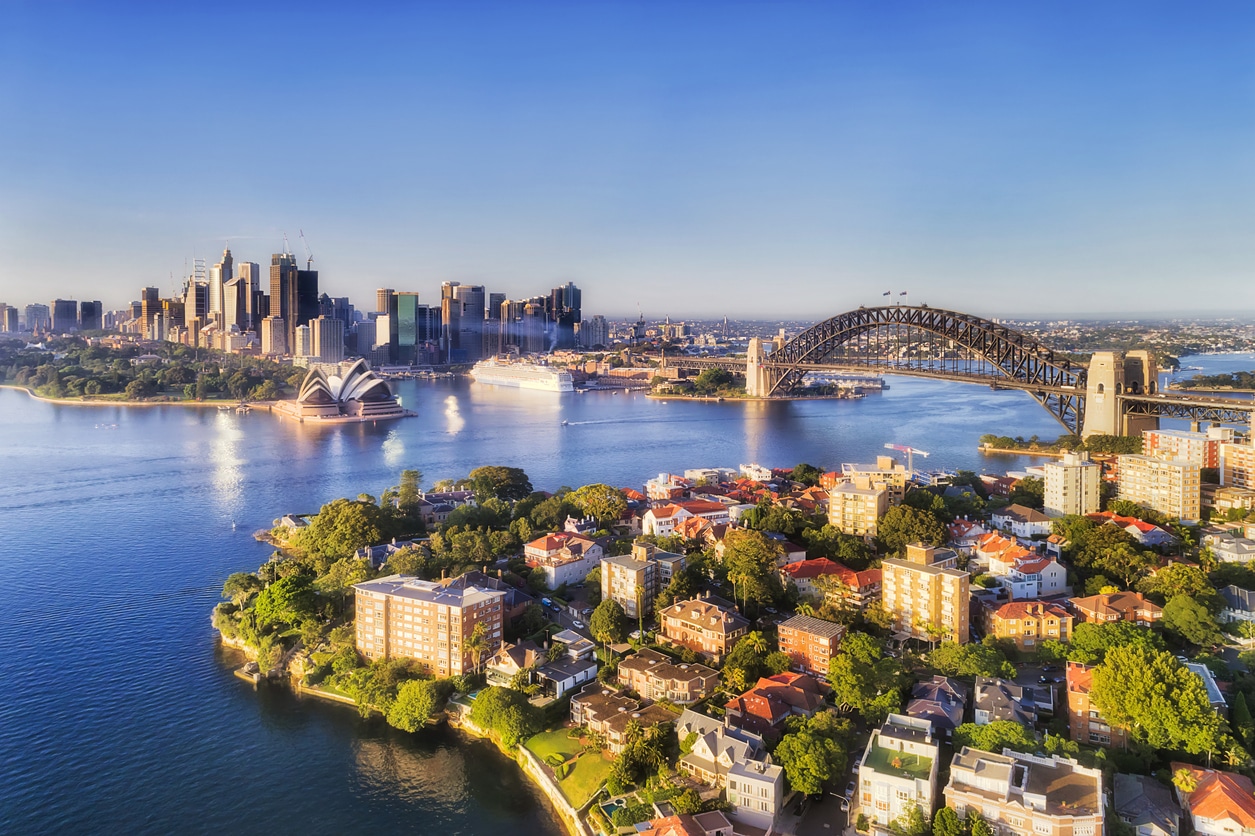There’s something magnetic about Australia’s sunshine, wide-open spaces, and habit of turning every meal into a barbecue. It’s not just the koalas and coral reefs—lately, more Americans are packing up for Sydney, Adelaide, or Queensland’s endless summer in search of a slower pace, friendly faces, and jobs that come with actual vacation days.
Of course, the decision to trade Times Square for kangaroos isn’t made lightly. Some are chasing adventure, some are following love or work, and others just want to see if “flat white” really is better than drip coffee. But before you go googling flights and shopping for SPF 50, it’s worth knowing that moving to Australia from the U.S. isn’t all shrimp on the barbie—there are real steps, costs, and quirks that catch even the most seasoned expats off guard.
📋 Key Updates for 2025
- Skilled visa income thresholds rose 4.6% effective July 1, meaning new Subclass 482 (and similar) visa applicants will need to meet higher salary requirements.
- U.S. Foreign Earned Income Exclusion increases to $130,000 for the 2025 tax year, giving expats a bigger cushion to avoid double taxation.
- Australian visa application charges (VACs) went up July 1, so expect higher fees on most visa subclasses if you’re lodging after that date.
Visa options for U.S. citizens: Your pathways down under
If you thought choosing between New York and Perth was tricky, just wait until you meet the Australian visa system. From skilled migration to partner visas, Australia offers a dizzying menu of pathways—each with its own set of forms, acronyms, and, yes, fees.
Here’s a quick look at the main type of visas:
- Skilled visas: If you’ve got work experience Australia needs (think healthcare, tech, engineering, or teaching), you could qualify for a work visa—like the Subclass 482 Temporary Skill Shortage visa. These can lead to permanent residency and, down the track, even Australian citizenship.
- Family and partner visas: Moving for love or family? Australia’s partner visa might be your ticket, but fair warning: it’s known for paperwork that could rival a Manhattan lease. Bring proof, patience, and a good printer.
- Student visas: Want to study at an Aussie university and hit the beach between lectures? The student visa is your golden ticket.
- Business and working holiday visas: Got dreams of launching a business in Perth or just want a year of sun and surf? Business and working holiday visas are on the table, too (if you’re under 35, you’re in luck).
The resident visa process—whether you’re aiming for temporary or permanent—can feel like its own adventure. Sometimes it’s worth bringing in a migration agent or reaching out to the Australian government’s Department of Home Affairs, especially if your situation is a little twisty.
The application process: What Americans need to know
If you’ve ever filled out a U.S. tax return, the Australian visa application process will feel oddly familiar—lots of forms, documents, and the occasional urge to stress-eat Tim Tams. But fear not! Here’s how it breaks down:
Step 1: Gather your documents
Be prepared to collect everything from your birth certificate to your college transcripts. Commonly required documents include:
- Valid U.S. passport
- Birth certificate
- Proof of employment or job offer (for skilled visas)
- Relationship evidence (for partner or family visas)
- Recent passport-style photos
Step 2: Police checks and health exams
Australia wants to know you’re of good character (and good health). That means:
- Police background checks from every country you’ve lived in for 12+ months.
- Health exams from a panel physician approved by the Australian government.
Step 3: Submitting your application
Everything goes through the Department of Home Affairs website. The site’s not exactly a day at the beach, but it’s manageable with patience (and plenty of saved passwords).
- Application wait times vary by visa subclass—skilled visas can take several months, while family visas (especially partner visas) may take a year or longer.
- You can check estimated processing times on the Department of Home Affairs website, but treat these numbers as friendly guidelines, not promises.
Step 4: Dealing with surprises
Paperwork purgatory? Got questions about a quirky family situation? This is where migration agents shine. They help:
- Double-check tricky forms.
- Manage sponsorships for family members.
- Communicate with the Department of Home Affairs so you don’t have to decipher “officialese” on your own.
💡 Pro Tip:
For Americans aiming to join Australian citizens—whether through skilled migration, family visas, or other routes—the application process is rarely quick or easy. But with a bit of grit (and maybe a migration agent in your corner), you’ll get there.
The real cost of moving to Australia: What to budget
Sticker shock is practically a rite of passage for Americans moving to Australia. Beyond the airfare and the kangaroo souvenirs, you’ll need to budget for a few surprises.
What can you expect to shell out for your big move?
- Flights: One-way tickets from the USA to Australia start at around AUD $1,200–$2,000, depending on your timing and how many bags you sneak past check-in.
- Shipping your stuff: International shipping isn’t cheap—expect to pay several thousand dollars to move a household, or save by downsizing to just a few suitcases. (Your coffee maker might have to fend for itself.)
- Visa and application fees: Australian visa application fees can range from a few hundred to several thousand AUD per person, depending on the subclass. Partner visas, for example, currently start at over AUD $8,000.
- Health insurance: Most visa holders (including skilled workers and students) are required to hold private health insurance—plan for about AUD $100–$200 per month for basic coverage.
- Up-front rent and deposits: Renting in major cities like Melbourne, Brisbane, or Adelaide? Be prepared for one month’s rent in advance, plus a security deposit. The rental market can be competitive, so having funds ready is key.
How does the cost of living compare?
- Housing in Australia’s big cities is pricey—think New York or Toronto, but with better beaches.
- Groceries and eating out are often more expensive than in the U.S. or Canada. (A flat white at a Sydney café will cost you, but it’s worth it.)
- Daily expenses like public transport, utilities, and yes, your phone bill, may run higher than you’re used to.
On the flip side, Australian wages tend to be strong, and you might find the lifestyle—outdoor markets, public parks, and free BBQs—offers value that money can’t buy.
💡 Pro Tip:
If you’re looking to save on the initial move, compare furnished vs. unfurnished rentals. Many Aussie apartments come fully kitted out—so you can skip the shipping container and start your new life with less hassle (and a lot fewer IKEA hex keys).
What life in Australia is really like for expatriates
Once you’ve made the leap across the Pacific, daily life in Australia is equal parts adventure and learning curve. You’ll spot plenty of familiar comforts—but also quirks, customs, and unexpected hurdles (most of them fun, some of them just…baffling).
Finding your home down under
Securing a family home or rental is practically a competitive sport, especially in cities like Sydney, Brisbane, Melbourne, and Adelaide. Expect open-house inspections that feel like speed dating and fierce competition for the good spots. In regional centers, things are more relaxed—but you might trade city buzz for a quieter, beachier life.
💡 Pro Tip:
Rental listings often use terms like “unfurnished” or “fully furnished.” You’ll also need references and a deposit just to be considered.
Where expats land
Most expats set up camp in the major cities: Sydney (harbor views!), Melbourne (café culture and creativity), Brisbane (sunshine galore), and Adelaide (a more laidback pace). Queensland’s coast is a hit with families. And, yes, even New Zealanders make the jump—there’s a real international mix almost everywhere you go.
Setting up your Aussie life
Once you’ve landed a place, it’s time to tackle the practical stuff—banking, public transport, phone plans, and the joys of Australian utility bills.
- Banking: Opening a bank account is straightforward. Bring your passport and proof of address. Most start with the “big four” banks.
- Public transport: Buses, trains, and trams rule in the cities. Grab a tap-and-go card like Sydney’s Opal or Melbourne’s Myki for stress-free commuting.
- Phone plans: SIM cards are everywhere, and contracts tend to be flexible. No years-long commitments.
- Utility bills: Electricity and water can be expensive, especially in summer with the A/C blasting. On the upside, public amenities—parks, pools, BBQs—are world-class (and often free).
With a bit of patience (and a love for a good sausage sizzle), you’ll find your groove.
Sorting out the essentials
Moving to Australia means a crash course in local systems—especially when it comes to healthcare, taxes, and your long-term nest egg.
Healthcare: Medicare vs. private insurance
Australia’s public healthcare system (Medicare) covers citizens and most permanent residents, but newcomers on temporary visas might not be eligible right away.
- Medicare: If you meet eligibility criteria (usually after gaining permanent residency), you’ll get subsidized doctor visits and hospital care.
- Private insurance: Many expats opt for a private policy to fill the gap, or just for extras like dental and vision.
Taxes: What you need to know
- Tax year: Runs July 1 to June 30—just to keep you on your toes.
- Income tax: You’ll pay Aussie income tax on your local earnings, with progressive rates.
- Superannuation: Think of this as Australia’s 401(k)—employers contribute, and you can too.
- Double taxation: U.S. citizens must file U.S. tax returns every year, no matter where they live. Thankfully, the U.S. and Australia have a tax treaty, but the paperwork can be intense.
💡 Pro Tip:
Many expats keep a U.S. or Canadian bank account or retirement plan active—just in case they move back or need coverage during visits. Before you do, check the tax rules or talk to a cross-border expert to avoid surprises.
Work, jobs, and starting over
Finding employment opportunities might feel like starting from scratch, but Australia’s job market is welcoming—and there are more paths than you might expect.
How to find work
Australia runs on networks and referrals. The formal application is only half the battle—friendly chats over coffee are often just as important.
- Visa categories: Your visa determines what you can do. Skilled workers (Subclass 482), permanent residents, and some temporary visa holders have broad access.
- Job boards: Government sites like JobSearch, plus SEEK and Indeed, are full of opportunities.
- Networking: Migration agents, recruiters, and LinkedIn groups are great resources. Aussies are helpful, so don’t be shy.
💡 Pro Tip:
Join professional associations or local LinkedIn groups before you arrive. You’ll tap into job leads and insider advice—maybe even score your first coffee meeting.
What makes Aussie workplaces unique?
Australian offices value teamwork over titles, and informality is the norm. Don’t be surprised if meetings are brisk, decisions happen over coffee, and everyone—from CEO to intern—gets included in the office banter. Hard work is balanced with real downtime—think “Friday arvo drinks,” footy tipping contests, and group charity events. It’s a culture that works hard and actually plays hard, too.
Day-to-day life down under is packed with new experiences, from figuring out your first utility bill to joining your workplace’s rugby tipping competition. But with an open mind and a willingness to ask questions, you’ll settle in—and find plenty of surprises to love.
Cultural shocks and everyday surprises
You might think Australia is just like the U.S. with better beaches and more kangaroos, but every new expat learns: there’s plenty that will catch you off guard (and usually make for a good story later).
What to expect
So what actually feels different once you land? The little things—like how people greet you or line up for coffee—can throw you for a loop at first. Here are a few everyday surprises that might just become your favorite Aussie quirks.
- “How ya going?” and other local lingo: Australians are famously laidback, but their greetings can leave Americans momentarily confused. (“How ya going?” means “How are you?”—not “Which way are you headed?”)
- Brunch is a competitive sport: Want a table at that trendy café in Sydney or Melbourne? Get ready to queue. Aussies take their flat whites and smashed avo seriously.
- The public healthcare system: Adjusting to Medicare can feel surreal after U.S. insurance headaches. Most basic care is covered, but private health insurance is common too—especially if you want extras or shorter wait times.
- School terms and schedules: The academic year runs from January to December (goodbye, summer vacation as you knew it), and school uniforms are the norm.
Fitting in and building connections
Australians are friendly but can be reserved at first—don’t take it personally! The secret to finding your people?
- Join a local sports team or fitness group (even if you’re new to cricket).
- Check out community clubs or “meetup” events in your city.
- Tap into expat networks—there’s a solid American community in every major city, ready to trade homesickness stories and celebrate Thanksgiving (even if it’s on a random Thursday).
Adjusting takes time, but these everyday quirks and friendly traditions are all part of the adventure.
Your new life down under awaits
If you’re dreaming of sunny weekends, beachside barbecues, and calling Australia home, there’s plenty to look forward to. But before you get too swept up in surfing lessons and learning the difference between a flat white and a long black, it’s worth remembering that your U.S. tax obligations don’t disappear just because you’ve moved down under.
That’s where Bright!Tax comes in. We help American expats keep their U.S. tax filings in order, no matter where life takes them. If you need a hand navigating your expat tax returns from Australia, just reach out—we’ll make sure you’re sorted, so you can focus on enjoying the view.
Frequently Asked Questions
-
Do I have to keep filing U.S. taxes after moving to Australia?
Yes—U.S. citizens are required to file a U.S. tax return every year, even when living abroad. The good news? Australia and the U.S. have a tax treaty to help prevent double taxation, but you’ll still need to keep up with both countries’ rules.
-
How long does it take to get an Australian visa?
It depends on the type of visa you apply for. Skilled worker and family visas can take several months to over a year, while student and working holiday visas are often quicker. Always check the latest processing times with the Australian Department of Home Affairs.
-
What’s the cost of living like in Australia compared to the U.S.?
Australia’s big cities are known for great quality of life, but also higher prices—especially for housing, groceries, and eating out. On the bright side, wages tend to be strong and the lifestyle is famously relaxed.
-
Can I use my U.S. bank account in Australia?
You can keep your U.S. account open, and many expats do, especially for managing retirement or paying bills back home. However, you’ll also need an Australian account for everyday life and work.
-
Will I be eligible for Australian healthcare (Medicare) as an expat?
Not right away—most temporary visa holders will need private health insurance. Permanent residents and citizens can access Medicare, Australia’s public healthcare system.
-
Is it easy to find work as an American in Australia?
It depends on your skills, visa status, and where you’re looking. Some professions are in high demand, but you’ll need the right visa to work legally. Networking and being open to new opportunities can make a big difference.
-
What does Bright!Tax do for expats in Australia?
Bright!Tax helps American expats stay compliant with their U.S. tax obligations by preparing and filing U.S. tax returns from abroad. We know the ins and outs of expat tax laws—so you can focus on your new adventure, not IRS paperwork.

 Connect on LinkedIn
Connect on LinkedIn

